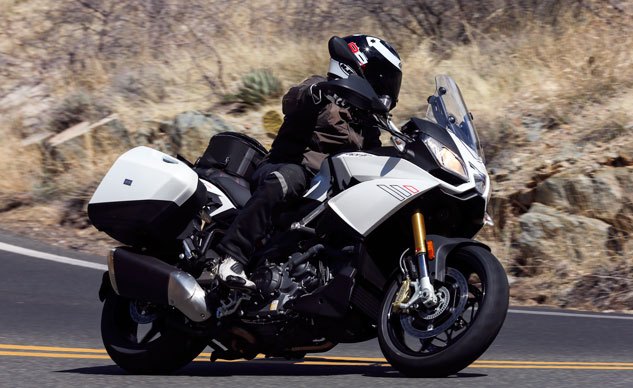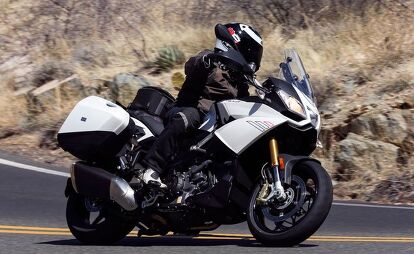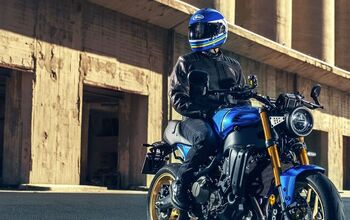2015 Aprilia Caponord 1200 ABS Travel Pack Review + Video

Now, more than ever, a computer on wheels.
Aprilia has been missing from the Adventure-Touring landscape for some time. With focus placed on its two-time World Superbike Championship-winning RSV4 Superbike, now that the racing landscape has been conquered, the Noale marque is carrying that success in other directions with the Caponord 1200 ABS Travel Pack. With four patents to its name, Aprilia is entering the ultra-competitive Adventure-Touring market with guns a-blazing.
2015 Aprilia Caponord Travel Pack
| Engine | 17.5/20 |
| Suspension/Handling | 14/15 |
| Transmission/Clutch | 9/10 |
| Brakes | 8/10 |
| Instruments/Controls | 4/5 |
| Ergonomics/Comfort | 9/10 |
| Appearance/Quality | 8/10 |
| Desirability | 8/10 |
| Value | 9.5/10 |
| Overall Score | 87/100 |
According to Miguel Galluzzi, Director for the Piaggio Advanced Design Center, and lead designer for the Caponord, as well as the Moto Guzzi California, Ducati Monster, and many others, the bike’s design stage started a little over three years ago. Why the delay in coming to market?
Part of the reason was the focus on the RSV4, but another reason was because, “We didn’t want to design an elephant like the BMW [R1200GS], or a pig like the Ducati [Multistrada],” Galluzzi said. “We wanted a simpler look that was different from everyone else.”
True to his word, the Caponord has unmistakable Adventure-Touring style, but the RSV4-esque nose section captures a theme the guys in Aprilia shirts kept saying over and over during their tech briefing: sport riding is Aprilia’s heart and soul. So much so, that nowhere in Aprilia’s presentation of the bike was there an instance of it touching the dirt. Instead the faux Adventure-Tourer, equipped with Dunlop Qualifier II tires, on the exact same wheels as the RSV4 even, was shown in a variety of street situations. From two-up touring in the countryside, to solo canyon blasting, the Caponord’s confusing appearance and actual abilities should realistically place it out of the Adventure-Touring segment and into the Sport-Touring realm.
A Rose By Any Other Name
Whatever you want to call it, on paper the Aprilia Caponord has the ingredients to shake up the ever-evolving landscape of motorcycles designed to take people long distances on the twistiest roads possible. Our European correspondent, Tor Sagen, already spent time with this bike at its European introduction last year, but there are a few specifics worthy of talking about in greater detail.
Starting with the engine, the 1197cc 90-degree V-Twin borrowed from the Dorsoduro 1200 receives 52mm throttle bodies (from 57mm). Each cylinder gets twin injectors and two spark plugs. A tall final-drive ratio helps with gas mileage, and the 690-watt alternator means you can plug in whatever electronic accessories you need to stay warm, find your way, or both.
However, in an unusual twist to our normal script, the engine is not the center of attention here. Instead, the bevy of electronics and sophisticated suspension takes center stage. Beginning with items probably familiar to most of you, the Caponord comes with two-position ABS (on/off), three riding modes (Touring, Sport, Rain), three-position traction control (four including off), and ACC (Aprilia Cruise Control) which is similar to that seen on the Moto Guzzi California.
So far, all of this pales in comparison to the Caponord’s advanced suspension, curiously dubbed ADD, or Aprilia Dynamic Damping. With four patents to its name, ADD is the first production motorcycle to offer a semi-active fork and active shock. What this means from the saddle is a smooth, composed ride, no matter the road conditions.
At the push of a button, the electronic suspension can adjust to one of four different pre-set suspension settings (solo, solo with luggage, two-up, and two-up with luggage). This isn’t too dissimilar to other motorcycles on the market, but what sets the Caponord apart is its full automatic suspension mode.
Taking a closer look at the system, the swingarm is equipped with a potentiometer to track its stroke, while the fork sees Aprilia’s first patent: its exclusive fork air pressure sensor mounted atop the left fork stanchion. By measuring the air pressure within the fork tube, the ECU’s algorithms can calculate what position it’s in and provide appropriate damping in real time. It does not, however, change spring preload. That’s still done manually.
The question now becomes determining the amount of damping to provide. This is a function of the software. Marco Zuliani, of Aprilia Product Marketing, described two different methods for managing the data collected by the sensors, both of which are borrowed from the automotive sector.
Skyhook, the first method, might be a familiar term, considering its usage on the Ducati Multistrada 1200 S Touring. However, according to Aprilia, Skyhook technology has been around since 1974, and works best in managing low-frequency waves (imagine riding over long rolling undulations). The second method, known as acceleration driven damping, is ideal for high-frequency waves (say, hitting a pot hole).
With comfort a central design theme for the Caponord, Aprilia engineers developed a new, proprietary algorithm mixing elements of both software methods, earning the second patent in the process. The third patent again deals with software settings. Dubbed the Aprilia map-builder, this set of algorithms is the brains behind the automatically adjusting suspension, which leads to the fourth patent: the active rear shock. The first production unit of its kind, the shock is able to electronically adjust damping and spring preload, factoring the added weight of pillion, luggage, fuel load, and road conditions to adjust damping settings completely on its own.
While riding, the ECU is constantly monitoring the throttle position, front brake position, and road speed to determine what settings to adjust. All told, Aprilia says the Caponord takes just ten milliseconds to change through its entire damping range.
Riding On Clouds
To see just how well the Caponord and the oddly named ADD works, Aprilia invited journos to Prescott, Arizona, to put the new bike to task. Straight away, I noticed the rider triangle is quite comfortable for my 5-foot, 8-inch frame. The seat is 33.0 inches high, but touching the ground isn’t so difficult thanks to the narrow seat/fuel tank junction. Looks are deceiving, though, as the narrow junction belies the tank’s 6.3-gallon capacity.
Thumb the starter and the booming V-Twin comes to life, its vital signs showing on the LCD gauge cluster stuffed full with information, including revs, speed, gear position, ride mode setting, ADD setting, and others. And if that isn’t enough, iPhone users can take advantage of the Aprilia Multimedia Platform (an Android version is in the works). Similar to the Zero electric motorcycle app, AMP pairs via Bluetooth to the Caponord, providing a secondary dash display, assuming you have a handlebar mount for the phone.
Equipped with five different menus, AMP can display everything from acceleration Gs (both positive and negative), thrust, rear-wheel-slip percentage, lean angle, turn-by-turn directions, even the distance from wherever you are to the North Cape of Norway (get it, Capo Nord?). The Trip menu stores data from your ride that you can email to yourself, or others, later. Aprilia says AMP will likely find its way to the rest of the model line, minus the North Cape feature.
Power from the big Twin is good. Bottom-end and midrange oomph didn’t leave me wanting for more, while the bike really comes alive in the top end. Considering it’s been some time since I’ve ridden the Ducati Multistrada, I’ll save the comparisons to the Capo’s most obvious opponent for another time, except to say the engine feels healthy. The ride-by-wire throttle facilitates the three riding modes, and though Touring feeds in the power smoothly, I preferred Sport mode for its slightly more aggressive nature.
I was a bit let down to shift manually, without the aid of a quickshifter, considering all the talk about Aprilia’s sporting nature. There’s no slipper clutch, either, but really, the Capo shifts smoothly in either direction.
But enough with the engine, the real talking point with the Caponord is the suspension. Choosing between the four manual modes does offer a noticeable difference in firmness, especially if you switch directly from solo mode to two-up with luggage. However, full automatic mode lets you “set it and forget it.” Entering this ride with reserved optimism after reading Sagen’s experience with the system, I can now say that our Euro correspondent was spot-on in his assessment.
I left the ADD in full auto mode for the majority of the ride and never felt a reason to change it. Remembering Aprilia’s goals of comfort and sport, the highway slab to the twisty roads of Jerome were done in absolute delight, as nothing seemed to upset the chassis. At one point, I deliberately rode along the rumble strips placed at the edge of the road to jolt weary motorists back to life. Despite my eyes seeing the ripples in front of me, it was near impossible to feel them at the bars.
The system is equally adept when the road gets curvy, as hard acceleration out of corners results in negligible squat. Meanwhile, under hard braking into corners, front compression firms up while rear rebound slows, minimizing dive. Once you’re off the brakes and turning, the suspension adjusts again. Some might equate the learning curve associated with the ADD suspension as similar to riding the BMW Telelever for the first time: it’s different than what you’re used to, but once you get used to it, it’s really an impressive thing to behold.
A 61.6-inch wheelbase means the Capo isn’t the quickest to turn, but the wide bars do give ample heft to throw the bike around. Brembo four-piston monoblocs provide stopping force, and are mated to 320mm discs. They work well, although initial bite at the lever seemed a little soft. But there was never any issue, and should you need ABS, its intervention comes on smoothly.
Impressive as it is, the Caponord does have a few minor faults. The manual windscreen, while providing decent protection, seems a bit out of place for such a high-tech bike. Also, as noted before, the lack of a quickshifter is an oddity, though not a deal breaker.
However, the biggest gripe is the cumbersome nature of the Aprilia Cruise Control. Activated via a button on the right grip, once the desired speed is reached, you must press the button again. Seems simple enough, but its location is hard to reach with my thumb, requiring me to use my left hand. Further, there is no ability to adjust speed up or down. Doing so means re-adjusting your speed manually and starting the process all over again.
Touring In Style
At $15,499, the Caponord 1200 is a whopping $4500 cheaper than the similarly equipped Ducati Multistrada 1200 S Touring. As our day in Arizona proved, it’s a wonderful touring companion, with plenty of room in the 7.7-gallon saddlebags to carry a weekend’s worth of stuff.
View more pictures of the Aprilia Caponord 1200 in our gallery
I’m truly impressed with the overall package Aprilia has delivered. The engine is strong and flexible, with good around-town usability that won’t leave you bored in the twisties or long-distance tour. But the real shining gem is the combination of the electronics and suspension. Both are so well sorted it’s hard to imagine what Aprilia (or anyone else for that matter) is going to come up with next.
I’m hesitant to call the Caponord the new king of the class, especially since its off-road abilities are minimal, but it definitely puts up a strong fight against its competition in what Content Editor Tom Roderick dubbed the Sport-Adventure-Touring class. At the very least, I’m ready to nominate Aprilia the “Best Bang for the Buck” award of 2014. To stuff all that tech into the sub-$16k Caponord is truly amazing. Now, all that’s left to do is stack it up with its rivals to see who really is top dog. Stay tuned, as that’s just what we plan to do.
+ Highs
- Very trick suspension works as advertised
- Comfortable enough for the longest of adventures
- Fantastic bang for the buck
– Sighs
- Cruise control is cumbersome
- No quickshifter
- Manual windscreen seems low-tech here

Troy's been riding motorcycles and writing about them since 2006, getting his start at Rider Magazine. From there, he moved to Sport Rider Magazine before finally landing at Motorcycle.com in 2011. A lifelong gearhead who didn't fully immerse himself in motorcycles until his teenage years, Troy's interests have always been in technology, performance, and going fast. Naturally, racing was the perfect avenue to combine all three. Troy has been racing nearly as long as he's been riding and has competed at the AMA national level. He's also won multiple club races throughout the country, culminating in a Utah Sport Bike Association championship in 2011. He has been invited as a guest instructor for the Yamaha Champions Riding School, and when he's not out riding, he's either wrenching on bikes or watching MotoGP.
More by Troy Siahaan

















































Comments
Join the conversation
Hey Troy . . Like your review, but just a couple of corrections on you CRUISE CONTROL [CC] outline AND some comments on the fuel gauge / consumption.
As a [very happy] owner [who test rode the Multistrada 3 times before buying the CAPO] I found that the Cruise Control button / setting is one of those functions that become second nature once you've had a few decent rides on the bike.
I'm really happy with the CC and find that the big twin easily regulates the set speed in response to inclines and downhill sections.
I never need to use my left hand . . . it's just a case of working out how to best use own right hand grip to activate the button, and once 'engaged', it's easy to set the speed you've chosen to cruise on.
You mentioned that you need to be doing 60mph before you can set it. That's incorrect. As a professional reviewer you need to get your facts straight before you publish a review.
You can set the CC from 3rd gear as low as 31mph . . . from their it's a sliding scale . . . ie: set in 4th gear from 37mph and so on.
You CAN accelerate with the CC set in 3rd gear and above with an upper limit for each gear [at which point the CC is temporarily deactivated. EG: in 6th you can set the CC from as low as 43mph [why would you want to?] and accelerate up to 111mph before that speed will deactivate the CC. You really wouldn't need to have CC set at over 111mph.
FUEL Gauge / Consumption . . . The fuel gauge [fro reasons only known to Aprilia] gives the LAST bar 3x the mileage left Vs the other bars. IE: when you get down to the last bar on the gauge, it's the equivalent of 3 of the 'earlier' bars. Go figure. :-)
I average 50mpg with some 'serious' canyon carving and long touring at say 80mph+.
As for looks, I certainly don't think it's the most beautiful bike in the world, but it's far from the worst. The Aprilia 'family' look is good and the trellis frame is nice. It handles beautifully.
When I tested the Multistrada over and over in comparison [before buying the CAPO] it certainly WASN'T because of the Duc's good lucks . . . It does look like a duck / goose on heat, but it is a great bike . . . just a bit too rough compared to the CAPO 1200 for LONG distance touring and as an all round bike, IMO. And the Multistrada's Cruise Control IS using your left hand, PERMANENTLY. :-p
So far I love the Aprilia . . . it's a great canyon carver, gobbles up the long distance and has some great extras [eg:: the Cruise Control] .
We have about 1800 miles on our demo I've put about 300 on it & the CC takes a little getting used to after the third couple hour rides its becomes more natural -